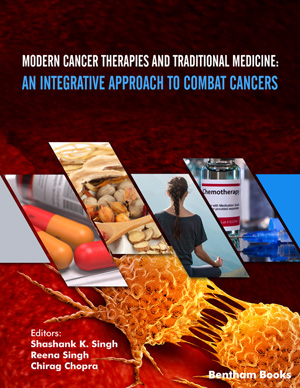[1]
Chatterjee, A.; Pakrashi, S.C. The Treatise on Indian Medicinal
Plants; Publications and Information Directorate, CSIR: New
Delhi, India, 1992, pp. 66-68.
[2]
Attal, A.R.; Otari, K.V.; Shete, R.V.; Upasani, C.D.; Nandgude, T.D. Abrus precatorius Linnaeus. A Phytopharmacological Review. J. Pharm. Res., 2010, 3, 2585-2587.
[3]
Gupta, S.P.; Chhabru, B.S. New triterpenoid glycosides from Abrus prcatorius. J. Indian Chem. Soc., 2012, 89, 675-677.
[4]
Ross, I.A. Medicinal Plants of the World, Vol. 1 (2nd ed); Chemical
Constituents, Traditional and Modern Medicinal Uses. , 2003, pp. 15-31.
[5]
Garaniya, N.; Bapodra, A. Ethno botanical and Phytophrmacological potential of Abrus precatorius L.: A review. Asian Pac. J. Trop. Biomed., 2014, 4(Suppl. 1), S27-S34.
[6]
Davis, J.H. Abrus precatorius (rosary pea). The most common lethal plant poison. J. Fla. Med. Assoc., 1978, 65, 188-191.
[7]
Reedman, L.; Shih, R.D.; Hung, O. Survival after an intentional ingestion of crushed Abrus seeds. West. J. Emerg. Med., 2008, 9, 157-159.
[8]
Maiti, P.C.; Mukherjea, S.; Chatterjee, A. Chemical examination of seeds of Abrus precatorius. J. Indian Forensic Sci., 1970, 9, 64-68.
[9]
Johnson, R.C.; Zhou, Y.; Jain, R.; Lemire, S.W.; Fox, S.; Sabourin, P.; Barr, J.R. Quantification of L-abrine in human and rat urine: A biomarker for the toxin abrin. J. Anal. Toxicol., 2009, 33, 77-84.
[10]
Ghatak, N.; Kaul, R. Chemical examination of the seeds of Abrus precatorius. J. Indian Chem. Soc., 1932, 9, 383-387.
[11]
Ghosal, S.; Dutta, S.K. Alkaloids from Abrus precatorius. Phytochemistry, 1971, 10, 195-198.
[12]
Gupta, N.C.; Singh, B.; Bhakuni, D.S. Steroids and triterpenoids from Alangium lamarckii, Allamanda cathartica, Abrus precatorius and Holoptelea integrifolia. Phytochemistry, 1969, 8, 791-792.
[13]
Markham, K.R.; Wallace, J.R.; Niranjan Babu, Y.; Krishna Murthy, V.; Gopala Rao, M. 8-C-Glcusylscutellarein 6,7-dimethyl ether and its 2˝-O-Apioside from Abrus precatorius. Phytochemistry, 1989, 28, 299-301.
[14]
Alessandro, L.; Franco, D. ’ Giovauni Battista, M.; Deise Lia Barros, C.; Ivan Leoncio, D. Abruquinones: new natural isoflavones. Gazz. Chim. Ital., 1979, 109, 9-12.
[15]
Bharadwaj, D.K.; Bisht, M.S.; Mehta, C.K. Flavonoids from Abrus precatorius. Phytochemistry, 1980, 19, 2040-2041.
[16]
Rose, P.W.; Beran, B.; Bi, C.; Bluhm, W.F.; Dimitropoulos, D.; Goodsell, D.S.; Prlic, A.; Quesada, M.; Quinn, G.B.; Westbrook, J.D.; Young, J.; Yukich, B.; Zardecki, C.; Berman, H.M.; Bourne, P.E. The RCSB Protein Data Bank: redesigned web site and web services. Nucleic Acids Res., 2011, 39(Suppl. 1), D392-D401.
[17]
Hnawell, M.D.; Curtis, D.E.; Lonie, D.C.; Vandermeersch, T.; Zurek, E.; Hutchison, G.R. Avogadro: an advanced semantic chemical editor, visualization, and analysis platform. J. Cheminform., 2012, 4, 17.
[18]
Liang, J.; Edelsbrunner, H.; Woodward, C. Anatomy of protein pockets and cavities: measurement of binding site geometry and implications for ligand design. Protein Sci., 1998, 7, 1884-1897.
[19]
Morris, G.M.; Huey, R.; Lindstrom, W.; Sanner, M.F.; Belew, R.K.; Goodsell, D.S.; Olson, A.J. AutoDock4 and AutoDockTools4: Automated docking with selective receptor flexibility. J. Comput. Chem., 2009, 30, 2785-2791.
[20]
Seeliger, D.; de Groot, B.L. Ligand docking and binding site analysis with PyMOL and Autodock/Vina. J. Comput. Aided Mol. Des., 2010, 24, 417-422.
[21]
Schrödinger Release 2016-4: MS Jaguar, Schrödinger, LLC 2016.New York, USA.
[22]
The PyMOL Molecular Graphics System, Version 1.8 Schrödinger,
LLC. New York, USA, 2015.
[23]
Pettersen, E.F.; Goddard, T.D.; Huang, C.C.; Couch, G.S.; Greenblatt, D.M.; Meng, E.C.; Ferrin, T.E. UCSF Chimera-a visualization system for exploratory research and analysis. J. Comput. Chem., 2004, 25, 1605-1612.
[24]
Trott, O.; Olson, A.J. AutoDock Vina: improving the speed and accuracy of docking with a new scoring function, efficient optimization, and multithreading. J. Comput. Chem., 2010, 31, 455-461.
[25]
Haile, J.M. Mol. Dynamics Simulation., 18; , 1992. Wiley New York, USA .
[26]
Vichai, V.; Kirtikara, K. Sulforhodamine B colorimetric assay for cytotoxicity screening. Nat. Protoc., 2006, 1, 1112-1116.
[28]
Singh, P.; Bhardwaj, A. Mechanism of action of key enzymes associated with cancer propagation and their inhibition by various chemotherapeutic agents. Mini Rev. Med. Chem., 2008, 8, 388-398.

























